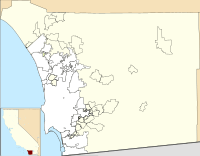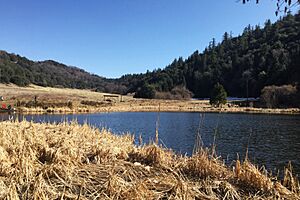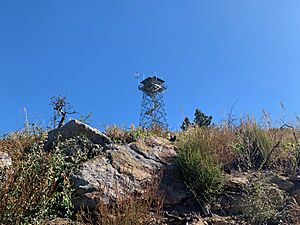Palomar Mountain facts for kids
Quick facts for kids Palomar |
|
|---|---|
| Monte Palomar (Spanish) | |

View of the Palomar Observatory located near the High Point summit of the Palomar Mountain range.
|
|
| Highest point | |
| Elevation | 6,142 ft (1,872 m) NAVD 88 |
| Prominence | 2,856 ft (871 m) |
| Listing | San Diego peak list |
| Geography | |
| Location | San Diego County, California |
| Parent range | Peninsular Ranges |
| Topo map | USGS Palomar Observatory |
| Climbing | |
| Easiest route | Road |
Palomar Mountain is a famous mountain ridge located in northern San Diego County, California. It's part of the Peninsular Ranges. This mountain is well-known for being home to the Palomar Observatory and its powerful Hale Telescope. It also features the beautiful Palomar Mountain State Park, a popular spot for nature lovers.
Contents
History of Palomar Mountain
The native Luiseño people had their own names for this area. They called Palomar Mountain Paauw and its highest point, High Point, was known as Wikyo.
The name Palomar comes from the Spanish language and means "pigeon roost" or "place of the pigeons." This name was given during the Spanish colonial era because many band-tailed pigeons lived on the mountain.
For a short time, the peak was called Mount Joseph Smith. However, in 1901, it went back to its original Spanish name, Palomar.
In the 1890s, enough people lived on Palomar Mountain to have three public schools. It was also a popular summer vacation spot for people from Southern California. There were three hotels and a "tent city" in Doane Valley every summer.
Nathan Harrison was the first African American to own land here. He bought land on the mountain's western side in the 1880s. He even built a road that became a popular route for tourists, known as Harrison's grade. Nathan was known for his funny stories about the mountain's animals, like grizzly bears and mountain lions. His cheerful personality made him a local celebrity among travelers.
Palomar Observatory: A Window to Space
Palomar Mountain is most famous for the Palomar Observatory. This observatory is home to the amazing Hale Telescope. When it was built in 1949, the 200-inch Hale Telescope was the largest and most important telescope in the world. It held this record until 1992.
Today, the observatory has four large telescopes. The newest one, added in 2021, is a 40-inch robotic infrared telescope. These telescopes help scientists study distant stars and galaxies.
Palomar Mountain State Park
Palomar Mountain is also home to the Palomar Mountain State Park, which is managed by the California State Park system. The park has campgrounds where families can stay for vacations. It also used to have a campground for local school children.
About 70,000 people visit the park each year. Even though there were some budget cuts in the past, the park and its campgrounds are still open for visitors.
The state park area of Palomar Mountain is covered with thick forests. You'll find many oak and conifer trees, like pine, cedar, and fir. Ferns grow everywhere in the shady parts of the forest. These trees and plants thrive because the mountain gets more than 30 inches of rain each year.
Since the 1920s, there has been a fire lookout tower on Boucher Hill on Palomar Mountain. This tower helps spot wildfires. It was closed for a while but reopened in 2012. Now, volunteers from the Forest Fire Lookout Association staff the tower. More than 11,000 visitors come to Boucher Hill each season. The tower is usually open from May 1st to early December, when fire season is active.
Doane Valley, inside the State Park, is also where the Camp Palomar Outdoor School is located. This school offers outdoor learning experiences for 6th-grade students from the San Diego Unified School District.
Oak Knoll Campground
At the bottom of Palomar Mountain, along County Route S6, you'll find Oak Knoll Campground. This place was once called Palomar Gardens. In the 1950s and 1960s, Palomar Gardens became famous because of its owner, George Adamski. He claimed to have met aliens, whom he called "Space Brothers."
Adamski had his own observatory at Palomar Gardens. He took pictures of objects in the night sky that he said were UFOs. In 1953, he wrote a bestselling book called Flying Saucers Have Landed, sharing his stories about meeting a friendly "Space Brother" from Venus.
The 1977 movie The Crater Lake Monster filmed many scenes on Palomar Mountain. Some scenes were even shot at the summit restaurant!
High Point: The Tallest Peak
High Point is one of the tallest peaks in the Palomar Mountain range. It reaches an elevation of 6,140 feet (1,871 m). While it's very tall, it's not the highest point in San Diego County. That title belongs to Hot Springs Mountain (at 6,533 feet (1,991 m)).
High Point is about two miles east of the Palomar Observatory. However, you can't get there directly from the observatory because that land is private. You can reach High Point by taking the Palomar Divide Truck Trail. This is a dirt road that starts near Warner Springs, California. It's a 13-mile trip one way, with a climb of 3000 feet.
You can also hike to High Point on the Oak Grove Trail. This is the oldest trail in the Palomar Ranger District. The hike is 13.5 miles roundtrip.
There's a working fire lookout tower on High Point, built in 1964. It's 70 feet tall, making it the tallest USFS fire tower in California! It was put back into service in 2009 and is staffed by volunteers.
Other nearby peaks include:
- Birch Hill (5,710 ft or 1,740 m)
- Boucher Hill (5,436 ft or 1,657 m)
Getting to Palomar Mountain
To get to the top of Palomar Mountain, you can take South Grade Road. This part of San Diego County Route S6 has more than 20 sharp turns, called hairpin turns, over a distance of less than 7 mi (11 km). It's a winding but scenic drive!
Climate and Nature
Palomar Mountain has a climate known as a hot-summer Mediterranean climate. This means it has hot, dry summers and cool, wet winters. The mountain gets about 30–35 inches of rain each year, mostly between October and April. Sometimes, snow falls during cold winter storms.
The humid climate helps a beautiful forest grow on the mountain. This forest is full of oak, pine, fir, and cedar trees.
The higher parts of Palomar Mountain have different natural environments than the lower foothills. The lower areas have chaparral and woodlands, which are plants that can handle dry conditions. The higher areas have California mixed evergreen forests with California black oaks, pines, firs, and other types of oaks and conifers. These higher elevations get much more moisture and can even get snow in winter.





